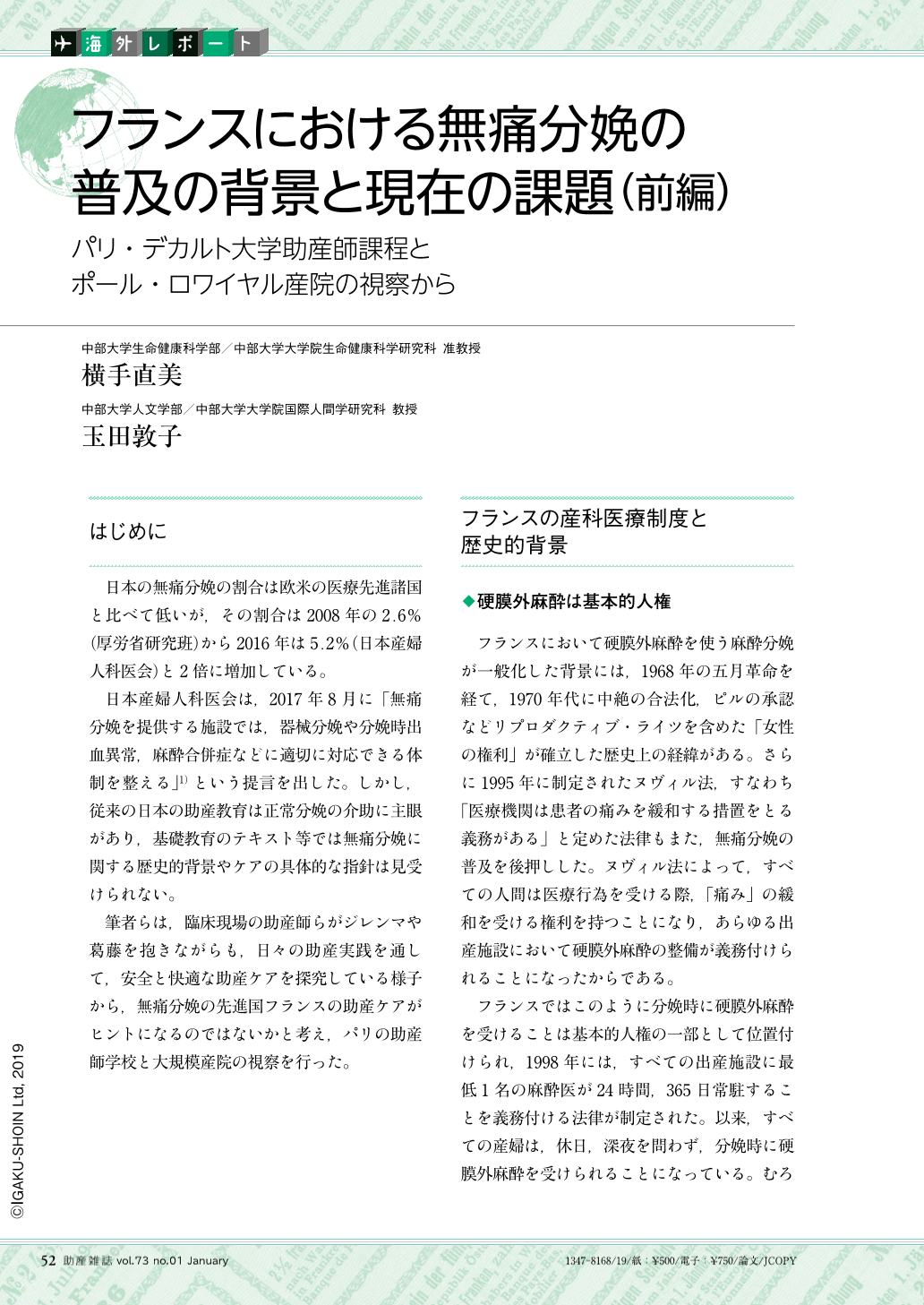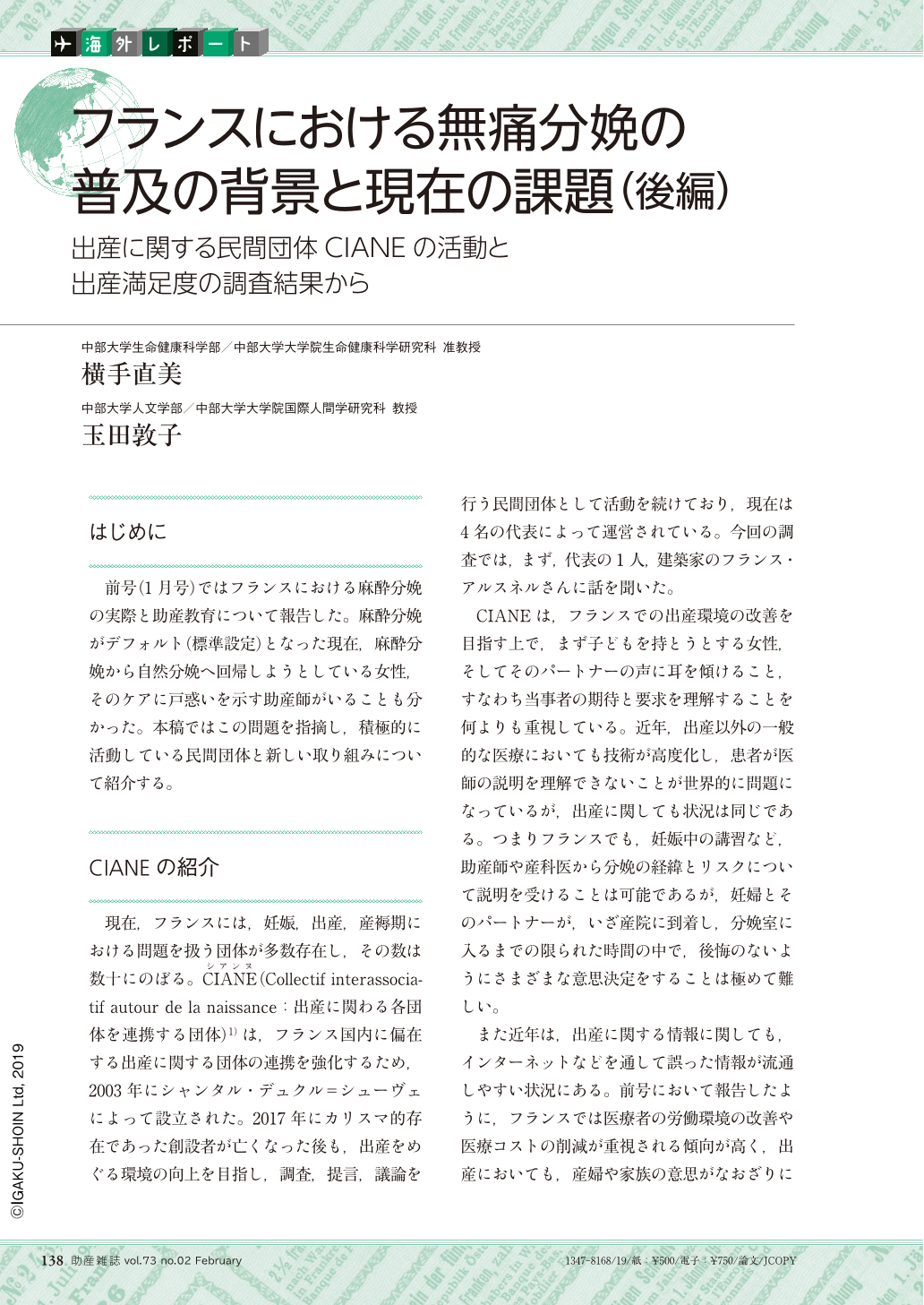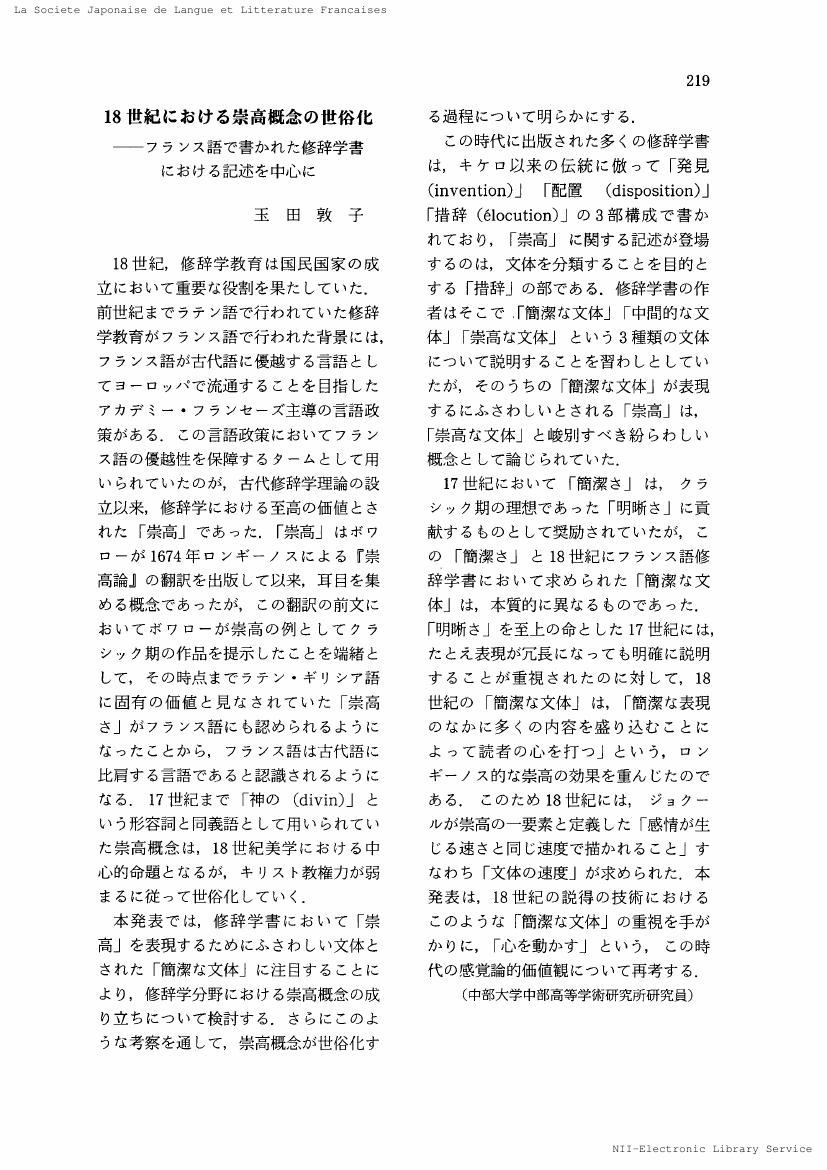はじめに 日本の無痛分娩の割合は欧米の医療先進諸国と比べて低いが,その割合は2008年の2.6%(厚労省研究班)から2016年は5.2%(日本産婦人科医会)と2倍に増加している。 日本産婦人科医会は,2017年8月に「無痛分娩を提供する施設では,器械分娩や分娩時出血異常,麻酔合併症などに適切に対応できる体制を整える」1)という提言を出した。しかし,従来の日本の助産教育は正常分娩の介助に主眼があり,基礎教育のテキスト等では無痛分娩に関する歴史的背景やケアの具体的な指針は見受けられない。 筆者らは,臨床現場の助産師らがジレンマや葛藤を抱きながらも,日々の助産実践を通して,安全と快適な助産ケアを探究している様子から,無痛分娩の先進国フランスの助産ケアがヒントになるのではないかと考え,パリの助産師学校と大規模産院の視察を行った。
- 著者
- 張 小鋼 玉田 敦子 坂本 貴志 伊東 貴之 川島 慶子 長尾 伸一 橋本 周子 逸見 竜生 隠岐 さや香 小関 武史 染谷 智幸
- 出版者
- 金城学院大学
- 雑誌
- 基盤研究(B)
- 巻号頁・発行日
- 2018-04-01
本年度は18世紀の東アジアの様相を多面的な視点から検討し、その相互比較を行うことを中心とした。そのため韓国18世紀学会に所属する研究者および中国人民大学清史研究所と密接に連絡しつつ国内での研究を進めた。2019年度は二つの学会が下記の通り開催された。前期は国際18世紀学会がイギリスのエジンバラ大学で開催された。そこで、日・韓・中共同セッションの企画・実施によって、18世紀の東アジア諸国の文化、政治、科学、風俗の展開を具体的に検討し、相互比較するとともに、三か国の研究者間の交流を深めつつ、国際的な観点から研究を進めた。その結果。朝鮮王朝、清朝、江戸時代の文化、風俗、政治、学問、文芸の多様な様態と、それらの諸国の18世紀における「社交性」の展開が、それぞれの歴史的文脈の中で明らかとなった。これに参加した研究者によって三国を結ぶ研究ネットワークを構築する方向性を確立した。後期は日本18世紀学会が中部大学で開催された。国際18世紀学会での討議を踏まえて、「ユーラシア近世史」の構想を発展させるべく、西洋、イスラム圏などの思想史的研究を行って、一定の見通しをたてるとともに、今後の研究ネットワークを構築していく作業を行った。秋以後は国際学会で得た成果をもとに、代表者、分担者がそれぞれの担当分野での研究を進め、次年度の国際会議(中国あるいは日本)に向けた準備を行った。またこの過程で、主に中国での18世紀研究とのネットワーク構築が進み、北京と上海という二つの拠点を中心に、韓国、日本との交流を進めることとなった。
13 0 0 0 OA 「啓蒙」と「熱狂」 ― フランスにおける「趣味判断」の由来と近代性 ―
- 著者
- 玉田 敦子 タマダ アツコ Tamada Atsuko
- 出版者
- 中部大学人文学部
- 雑誌
- 人文学部研究論集 (ISSN:13446037)
- 巻号頁・発行日
- vol.29, pp.145-165, 2013-01 (Released:2013-02-18)
9 0 0 0 OA 文体の速度と感覚論哲学 : 18世紀のフランス語修辞学教科書における記述を中心に
- 著者
- 玉田 敦子
- 出版者
- 日本フランス語フランス文学会
- 雑誌
- 日本フランス語フランス文学会中部支部研究報告集 (ISSN:02853795)
- 巻号頁・発行日
- no.31, pp.13-22, 2007-09
3 0 0 0 OA 「悦ばしき恐怖」から「リベルタン美学」へ : 18世紀における崇高概念の世俗化
- 著者
- 玉田 敦子
- 出版者
- 中部大学
- 雑誌
- 貿易風 : 中部大学国際関係学部論集 (ISSN:18809065)
- 巻号頁・発行日
- vol.3, pp.60-84, 2008
After the publication of Longinus's Peri Hupsous (On the Sublime), translated by Boileau in French in 1674, the concept of "sublime" became one of the most important subjects of the European intellectual society. Boileau's translation was subsequently translated again into English and published several times in England, thereby gaining a broader readership. Since then, Longinus's treatise and Boileau's added introduction have been invoked as the authority on the matter of sublimity, which was the ideal of the rhetoric discipline. If the concept of the sublime had a great impact on the French literary society of the time, it is because Boileau defined the sublime in a short sentence. In theories and treatises on rhetoric and aesthetics in Europe, despite always consulting Boileau's translation of Longinus's On the Sublime, the notion of the sublime became separated from its previous theological and "moral" connotation. Consequently, it seems necessary to clarify the process through which the concept of the sublime became secularized by analyzing theories and treatises on rhetoric published in the Age of Enlightenment. In England, sublime appears as a pleasure of the natural landscape rather than a notion of rhetoric. Poet and literary critic John Denis first used the expression "delightful horror" to express the pleasure afforded by Mount Ainguebelette in his letter written in Turino on October 25, 1688. Fifteen years later, in his "Proposition" from The Grounds of Criticism in Poetry, he explained this expression, trying to associate it with the theory of sublime written in the work of Longinus. Terror as the greatest passion subsequently became recognized as one of the main issues in aesthetic studies in England. Although, English authors such as Addison or Bailly often referred to Longinus, they considered the pleasure of landscape to be more interesting than the pleasure of literary works. As the status of awful scenery's beauty increased, the notion of sublime became separated from its previous sacred connotation, thereby providing a further aspect of the secularization of the notion. Finally, in A Philosophical Enquiry into the Sublime and Beautiful (1747), Edmund Burke demonstrated that "terror is a passion which always produces delight when it does not press too close." In France, the idea of the "natural sublime" appeared particularly in Salon de 1767, an art critique written by Diderot, who read Burke's Enquiry precisely. Such reception of the natural sublime in France prepared the public for the Romanticism in French literature, in which strong feelings, imagination, and representations of nature are important. In eighteenth-century France, the act of watching pains or distress of others required a pretext. According to Michel Foucault, during this age, exemplary punishment with show trials was considered the most useful for society. In this context, the delight received from the pains of others was explained by the deterrent effect of these punishments, which were perceived as "beauty" for the deterrent power itself. To prove the concept that a horrible spectacle is beautiful, authors of the time often referred to Montaigne and others from the sixteenth century. In the Age of Baroque, horrible spectacles were used to achieve religious and political purposes ; the stories of such spectacles were circulated to intensify their impact. In the Age of Enlightenment, La Motte, Batteux, and Marmontel attempted to define "sublime" as the effect of surprise expressed in "elegant" expression. According to the rhetoric theory of the time, "elegance" is defined as a grammatical license opposite to the grammatical "exactitude." Elegance brings changes and surprises in style with a license that creates rifts in the discourse and continues to have sensory pleasures. In this way, the sublime as the succession of surprises and intermittent changes-which Longinus and Boileau defined as one of the elements of the sublime-is associated with "elegance," a value that represents a "libertine" aesthetic.
3 0 0 0 近代国家の文化的アイデンティティ形成における古代表象の諸相
- 著者
- 玉田 敦子
- 出版者
- 奈良女子大学文学部
- 雑誌
- 奈良女子大学文学部研究教育年報 (ISSN:13499882)
- 巻号頁・発行日
- no.13, pp.11-18, 2016
- 著者
- 小関 武史 深貝 保則 玉田 敦子 坂本 貴志 武田 将明 松波 京子 川名 雄一郎 長尾 伸一 屋敷 二郎 福島 知己 福田 名津子 逸見 竜生 坂倉 裕治 隠岐 さや香 飯田 賢穂
- 出版者
- 一橋大学
- 雑誌
- 基盤研究(B)
- 巻号頁・発行日
- 2019-04-01
18世紀西洋の啓蒙は、科学、技術から政治思想に至る広範な領域で、19世紀以後の知の原型を与えたと考えられてきた。また20世紀後半以後の「近代」批判に対しては、啓蒙の現代的意義が主張されてきた。他方近年の啓蒙研究は、膨大な資料の丹念な発掘と読解、あるいはデジタル化などの新技術に基づき、当時のテクストを時代の文脈の中に位置づけ、多様で複雑な知の在り方を明らかにしてきたが、現代思想における近代批判や啓蒙の再評価に応える統一的な像を提起するには至っていない。本研究は啓蒙研究の現段階の方法と成果を総合し、「浮動する知の境界」という視点から多方面の貴重資料の分析を行い、啓蒙の知の総合的な解釈を試みる。
2 0 0 0 OA 18世紀フランスにおける「修辞学的崇高」の成立
- 著者
- 玉田 敦子
- 出版者
- 中部大学
- 雑誌
- 貿易風 : 中部大学国際関係学部論集 (ISSN:18809065)
- 巻号頁・発行日
- vol.2, pp.35-58, 2007-04-01
In eighteenth-century France, the concept of "the sublime" became the vogue. Great names such as Diderot and Rousseau often used "sublime" in their work, and other famous authors in the Age of Enlightenment, like La Motte, Batteux, and Marmontel, attempted to define the word. Treatises on rhetoric written in French at this time defined the sublime to be perfection in style that one must learn to attain. In the Age of Enlightenment, the Academie Francaise set up a linguistic policy in order to "purify" the French language, consulting the language of works published by French classical authors. The Academie's policy owed much to education in rhetoric in "college", and thus consecrated these works in the name of sublime. This paper deals with the intertextuality brought by two principal sources of treatises on the sublime in the eighteenth century in France: the introduction that Boileau added to Longinus' Peri Hupsous in 1674, and the article "Sublime" written by the Chevalier de Jaucourt in 1765. For that, it is necessary to clarify the process through which the concept of the sublime became secularized, by analyzing the treatises on rhetoric published in the Age of Enlightenment. In these treatises on rhetoric, always consulting Longinus' On the Sublime translated by Boileau, the notion of the sublime became separated from its previous theological connotation. If the concept of the sublime had a great impact on the French literary society of that time, Boileau defined the sublime in a short sentence. First of all, he distinguished the sublime from the "style sublime" that required the grandeur of hyperbolic expressions. Then, following the description of Longinus, Boileau defined the sublime as a simple expression that makes extraordinary and marvelous things. Not only this definition but also the passage in Genesis, "And said God let there be light, and there was light, " appear in the treatise on rhetoric as models of the sublime. The article "sublime" written in Encyclopedie became another authority on this concept. Jaucourt followed Boileau's succinct description closely, and then developed it into a full five pages by quoting ancient and classical French authors. Following the example of a contemporary author, Silvan, in his Traite du sublime, Jaucourt divided the notion into two categories: "sublime by images" and "sublime by sentiments." His article gave no more explanation than did Boileau's introduction, but explained in great detail the concept of "sublime by sentiment" that is represented through the acts of human beings. That provides a further aspect of the secularisation of the notion. While French classical literary theory pursued a simple style in the name of the "clearness of style, " in the next century, there emerged a preference for "style simple" but "concentrated." In the seventeenth century, communication had to be transparent, and this was achieved by means of using ample words in order to express rich and complex contents. However, in the following century, the rules changed drastically under the influence of the development of sensualism: it was only a "concentrated" style that could possibly create the energy required to express rich contents within short expressions. In this way, stylistic simplicity necessarily became closed to the sublime effect that transports an audience by means of concentrated expressions.
2 0 0 0 OA 18世紀における知識とマナー、秩序:公共知の東西比較
- 著者
- 高橋 博巳 安藤 隆穂 玉田 敦子 鷲見 洋一 伊東 貴之 川島 慶子 長尾 伸一 逸見 竜生 寺田 元一 渡辺 浩 堀田 誠三 渡辺 浩
- 出版者
- 金城学院大学
- 雑誌
- 基盤研究(B)
- 巻号頁・発行日
- 2014-04-01
当プロジェクトは、18世紀の公共知の東西比較を中心に、内外の研究者と共同研究を行ってきた。とくに朝鮮通信使を介しての日朝比較には、韓国の研究者と知見を共有し、当時の文芸共和国的な側面を解明することによって、これまで国ごとに分断されていた文学や思想の研究に新生面を開くことができた。これに比べると、清朝の文人や思想家とのより広範な知的交流の解明はなお道半ばと言わざるを得ず、より一層の深い解明が期待される。個別には伊東は『心身/身心と環境の哲学』、寺田・逸見らは『百科全書の時空 典拠・生成・時空』、長尾は『複数世界の思想史』において、従来の視点を大きく転換したり深化させて、新生面を開いている。
1 0 0 0 18世紀フランスにおけるミソジニー(女性嫌悪)とナショナリズム
本研究課題「18世紀フランスにおけるミソジニーとナショナリズム」は、フランス啓蒙のジェンダー的瑕疵を「近代」社会の構想が内在的に抱える矛盾、すなわち「マイノリティのマジョリティへの従属」の一形態と捉え、その核心として包括的に検討することを目指してきた。今年度は、以下の国際研究集会、研究会において研究報告をおこなった(題目等詳細は別記)。(1)ソルボンヌ大学(仏)のセリーヌ・スペクトール教授、リール第3大学(仏)のガブリエル・ラディカ准教授らとSkypeやメールにて打ち合わせを重ね、2019年7月に英国エジンバラにて開催される国際18世紀学会に「啓蒙期フランスにおける女性の地位とアイデンティティ」をテーマとしたセッションをアプライ、受諾された。(2)モンプリエ大学(仏)のクレール・フォヴェルグ氏がパリのCollege International de Philosophie において主宰するセミネールで「啓蒙期における表象の複数性」について招待講演をおこなった。(3)2014年より、奈良女子大学高岡尚子教授を中心として、同大学中川千帆准教授、駒澤大学倉田容子准教授とともに「ジェンダーと文学」をテーマに開催している研究会を本年度は中部大学にて開催した。また、文化的ナショナリズムの生成の起源を探究する試みとして、シチリアの僭主による文化戦略について考察する論文「レトリック発祥の地の輝きー紀元前5世紀の南シチリアにおける僭主政とオリンピック」を『中部大学人文学部研究論集』に執筆、刊行した。さらに今年度は女性史の観点から近現代フランスにおける分娩について考察し、『助産雑誌』に2本の共著論文を執筆した。
1 0 0 0 IR 18世紀フランスにおけるミソジニーとナショナリズム
- 著者
- 玉田 敦子
- 出版者
- 一橋大学社会科学古典資料センター
- 雑誌
- 一橋大学社会科学古典資料センター Study Series
- 巻号頁・発行日
- vol.72, pp.1-44, 2016-03-31
1 0 0 0 OA 18世紀における崇高概念の世俗化 : フランス語で書かれた修辞学書における記述を中心に
- 著者
- 玉田 敦子
- 出版者
- 日本フランス語フランス文学会
- 雑誌
- フランス語フランス文学研究 (ISSN:04254929)
- 巻号頁・発行日
- vol.90, pp.219, 2007-03-30 (Released:2017-08-11)
1 0 0 0 OA 18世紀フランスにおける「エネルギー」と近代の成立
1 0 0 0 IR 「啓蒙」と「熱狂」 : フランスにおける「趣味判断」の由来と近代性
- 著者
- 玉田 敦子
- 出版者
- 中部大学人文学部
- 雑誌
- 人文学部研究論集 (ISSN:13446037)
- 巻号頁・発行日
- no.29, pp.145-165, 2013-01
1 0 0 0 OA 18世紀の修辞学教科書における国家神話の創設
- 著者
- 玉田 敦子
- 出版者
- 日本フランス語フランス文学会
- 雑誌
- 日本フランス語フランス文学会中部支部研究報告集 (ISSN:02853795)
- 巻号頁・発行日
- no.32, pp.1-10, 2008-09






